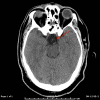Pituitary Apoplexy Following Elective Total Hip Replacement
- PMID: 37337556
- PMCID: PMC10277164
- DOI: 10.7759/cureus.40600
Pituitary Apoplexy Following Elective Total Hip Replacement
Abstract
Pituitary apoplexy is an endocrine-related emergency most commonly caused by hemorrhage into a preexisting pituitary adenoma. Known risk factors for such hemorrhage include major surgical procedures, head trauma, pregnancy, anticoagulation, and the administration of hormone therapies for the correction of primary hypothalamic deficiencies. Elective orthopedic surgery is an uncommon precipitator of pituitary apoplexy that is rarely described. We report the case of a patient with a previously unknown pituitary macroadenoma who developed apoplexy as a complication of elective right total hip arthroplasty.
Keywords: nonfunctioning pituitary adenoma; pituitary apoplexy; pituitary macroadenoma; total hip arthroplasty; transsphenoidal resection.
Copyright © 2023, Makadia et al.
Conflict of interest statement
The authors have declared that no competing interests exist.
Figures



Similar articles
-
ENDOCRINE OUTCOMES OF TRANSSPHENOIDAL SURGERY FOR PITUITARY APOPLEXY VERSUS ELECTIVE SURGERY FOR PITUITARY ADENOMA.Endocr Pract. 2019 Apr;25(4):353-360. doi: 10.4158/EP-2018-0488. Epub 2019 Jan 18. Endocr Pract. 2019. PMID: 30720340
-
Intraoperative hypovolemia as a possible precipitating factor for pituitary apoplexy: a case report.J Med Case Rep. 2023 Feb 10;17(1):53. doi: 10.1186/s13256-022-03738-4. J Med Case Rep. 2023. PMID: 36759850 Free PMC article.
-
Pituitary Apoplexy due to Pituitary Adenoma Infarction.J Korean Neurosurg Soc. 2008 May;43(5):246-9. doi: 10.3340/jkns.2008.43.5.246. Epub 2008 May 20. J Korean Neurosurg Soc. 2008. PMID: 19096606 Free PMC article.
-
Gestational pituitary apoplexy: Case series and review of the literature.J Gynecol Obstet Hum Reprod. 2019 Dec;48(10):873-881. doi: 10.1016/j.jogoh.2019.05.005. Epub 2019 May 3. J Gynecol Obstet Hum Reprod. 2019. PMID: 31059861 Review.
-
Pituitary macroadenoma causing symptomatic internal carotid artery compression: surgical treatment through transsphenoidal tumor resection.J Clin Neurosci. 2014 Apr;21(4):541-6. doi: 10.1016/j.jocn.2013.08.002. Epub 2013 Aug 23. J Clin Neurosci. 2014. PMID: 24211140 Review.
References
-
- New oral anticoagulants and pituitary apoplexy. Doglietto F, Costi E, Villaret AB, Mardighian D, Fontanella MM, Giustina A. Pituitary. 2016;19:232–234. - PubMed
-
- Clinical relevance of precipitating factors in pituitary apoplexy. Semple PL, Jane JA Jr, Laws ER Jr. Neurosurgery. 2007;61:956–962. - PubMed
-
- Cavernous sinus invasion might be a risk factor for apoplexy. Cinar N, Tekinel Y, Dagdelen S, Oruckaptan H, Soylemezoglu F, Erbas T. Pituitary. 2013;16:483–489. - PubMed
-
- Pituitary apoplexy: re-evaluation of risk factors for bleeding into pituitary adenomas and impact on outcome. Möller-Goede DL, Brändle M, Landau K, Bernays RL, Schmid C. Eur J Endocrinol. 2011;164:37–43. - PubMed
Publication types
LinkOut - more resources
Full Text Sources
